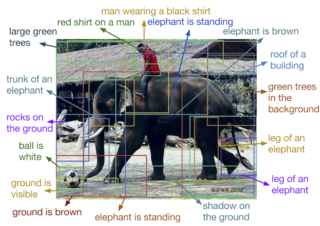Related Research Articles
The Association for Computing Machinery (ACM) is a US-based international learned society for computing. It was founded in 1947 and is the world's largest scientific and educational computing society. The ACM is a non-profit professional membership group, reporting nearly 110,000 student and professional members as of 2022. Its headquarters are in New York City.

Automatic image annotation is the process by which a computer system automatically assigns metadata in the form of captioning or keywords to a digital image. This application of computer vision techniques is used in image retrieval systems to organize and locate images of interest from a database.

Ricardo A. Baeza-Yates is a Chilean computer scientist that currently is the Director of Research of the Institute for Experiential AI at Northeastern University in the Silicon Valley campus. He is also part-time professor at Universitat Pompeu Fabra in Barcelona and Universidad de Chile in Santiago. He is an expert member of the Global Partnership on Artificial Intelligence, a member of the Association for Computing Machinery's US Technology Policy Committee as well as IEEE's Ethics Committee.

Thomas Shi-Tao Huang was a Chinese-born Taiwanese-American computer scientist and electrical engineer. He was a researcher and professor emeritus at the University of Illinois at Urbana-Champaign (UIUC). Huang was one of the leading figures in computer vision, pattern recognition and human computer interaction.
Michael S. Lew is a scientist in multimedia information search and retrieval at Leiden University, Netherlands. He has published over a dozen books and 150 scientific articles in the areas of content based image retrieval, computer vision, and deep learning. Notably, he had the most cited paper in the ACM Transactions on Multimedia, one of the top 10 most cited articles in the history of the ACM SIGMM, and the most cited article from the ACM International Conference on Multimedia Information Retrieval in 2008 and also in 2010. He was the opening keynote speaker for the 9th International Conference on Visual Information Systems, the Editor-in-Chief of the International Journal of Multimedia Information Retrieval (Springer), the co-founder of influential conferences such as the International Conference on Image and Video Retrieval, and the IEEE Workshop on Human Computer Interaction. He was also a founding member of the international advisory committee for the TRECVID video retrieval evaluation project, chair of the steering committee for the ACM International Conference on Multimedia Retrieval and a member of the ACM SIGMM Executive Committee. In addition, his work on convolutional fusion networks in deep learning won the best paper award at the 23rd International Conference on Multimedia Modeling. His work is frequently cited in both scientific and popular news sources.
ACM Multimedia (ACM-MM) is the Association for Computing Machinery (ACM)'s annual conference on multimedia, sponsored by the SIGMM special interest group on multimedia in the ACM. SIGMM specializes in the field of multimedia computing, from underlying technologies to applications, theory to practice, and servers to networks to devices.
Zhang Hongjiang is a Chinese computer scientist and executive. He was CEO of Kingsoft, managing director of Microsoft Advanced Technology Center (ATC) and chief technology officer (CTO) of Microsoft China Research and Development Group (CRD). Hongjiang is currently Chairman of BAAI. In 2022, he was elected to the National Academy of Engineering for his technical contributions and leadership in the area of multimedia computing.
Hans-Peter Kriegel is a German computer scientist and professor at the Ludwig Maximilian University of Munich and leading the Database Systems Group in the Department of Computer Science. He was previously professor at the University of Würzburg and the University of Bremen after habilitation at the Technical University of Dortmund and doctorate from Karlsruhe Institute of Technology.

Maarten de Rijke is a Dutch computer scientist. His work initially focused on modal logic and knowledge representation, but since the early years of the 21st century he has worked mainly in information retrieval. His work is supported by grants from the Nederlandse Organisatie voor Wetenschappelijk Onderzoek (NWO), public-private partnerships, and the European Commission.

Prabhakar Raghavan is a business executive and former researcher of web information retrieval. He currently holds the role of Chief Technologist at Google. His research spans algorithms, web search and databases. He is the co-author of the textbooks Randomized Algorithms with Rajeev Motwani and Introduction to Information Retrieval.

Shojiro Nishio is a Japanese information scientist and technology scholar and the 18th president of Osaka University. Having co-authored or co-edited more than 55 books and more than 650 refereed journal or conference papers as well as serving on editorial boards of major information sciences journals, Nishio is considered one of the most prominent and influential researchers on database systems and networks.
Klara Nahrstedt is the Ralph and Catherine Fisher Professor of Computer Science at the University of Illinois at Urbana–Champaign, and directs the Coordinated Science Laboratory there. Her research concerns multimedia, quality of service, and middleware.
Xilin Chen is a scientist from the Institute of Computing Technology in Beijing, China.
Mohan Kankanhalli from the National University of Singapore was named Fellow of the Institute of Electrical and Electronics Engineers (IEEE) in 2014 for contributions to multimedia content processing and security. He was named as an ACM Fellow, in the 2024 class of fellows, "for contributions to multimedia content processing and multimedia security".
Hong-yuan Mark Liao is a Taiwanese computer scientist specialized in the field of multimedia information processing and AI.

Yong Rui is the CTO of Lenovo Group, in charge of Lenovo's technical strategy, research and development directions, and Lenovo Research, one of Lenovo's most important innovation engines.
Shih-Fu Chang is a Taiwanese American computer scientist and electrical engineer noted for his research on multimedia information retrieval, computer vision, machine learning, and signal processing.
Jiebo Luo is a Chinese-American computer scientist, the Albert Arendt Hopeman Professor of Engineering and professor of computer science at the University of Rochester. He is interested in artificial intelligence, data science and computer vision.

Edward Y. Chang is a computer scientist, academic, and author. He is an adjunct professor of Computer Science at Stanford University, and Visiting Chair Professor of Bioinformatics and Medical Engineering at Asia University, since 2019.
Marcus Felipe Montenegro Carvalho da Fontoura, known as Marcus Fontoura, is a Brazilian computer scientist known for his contributions to cloud computing and large-scale distributed systems. He currently serves as a Technical Fellow at Microsoft.
References
- ↑ "2016 elevated fellow" (PDF). IEEE Fellows Directory. Archived from the original (PDF) on August 29, 2017.
- ↑ "2024 ACM Fellows Honored for Contributions to Computing That Are Transforming Science and Society". Association for Computing Machinery. January 22, 2025. Retrieved 2025-01-22.